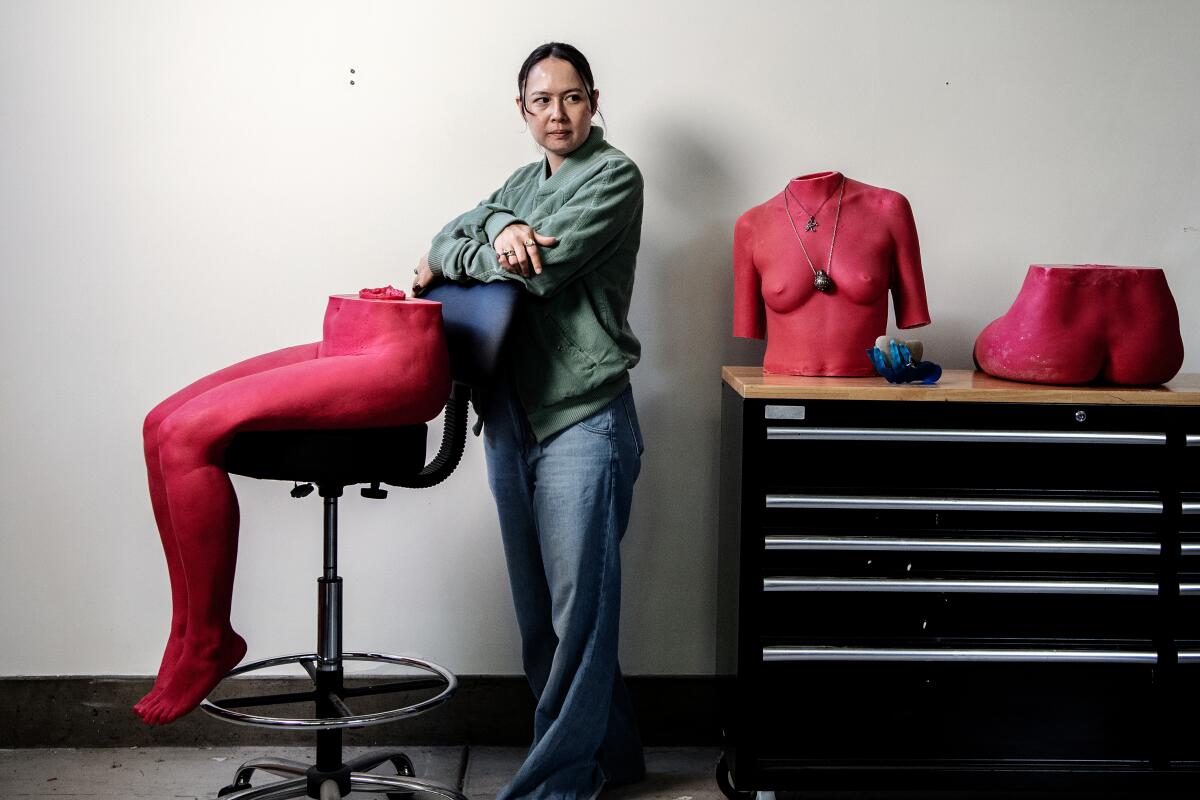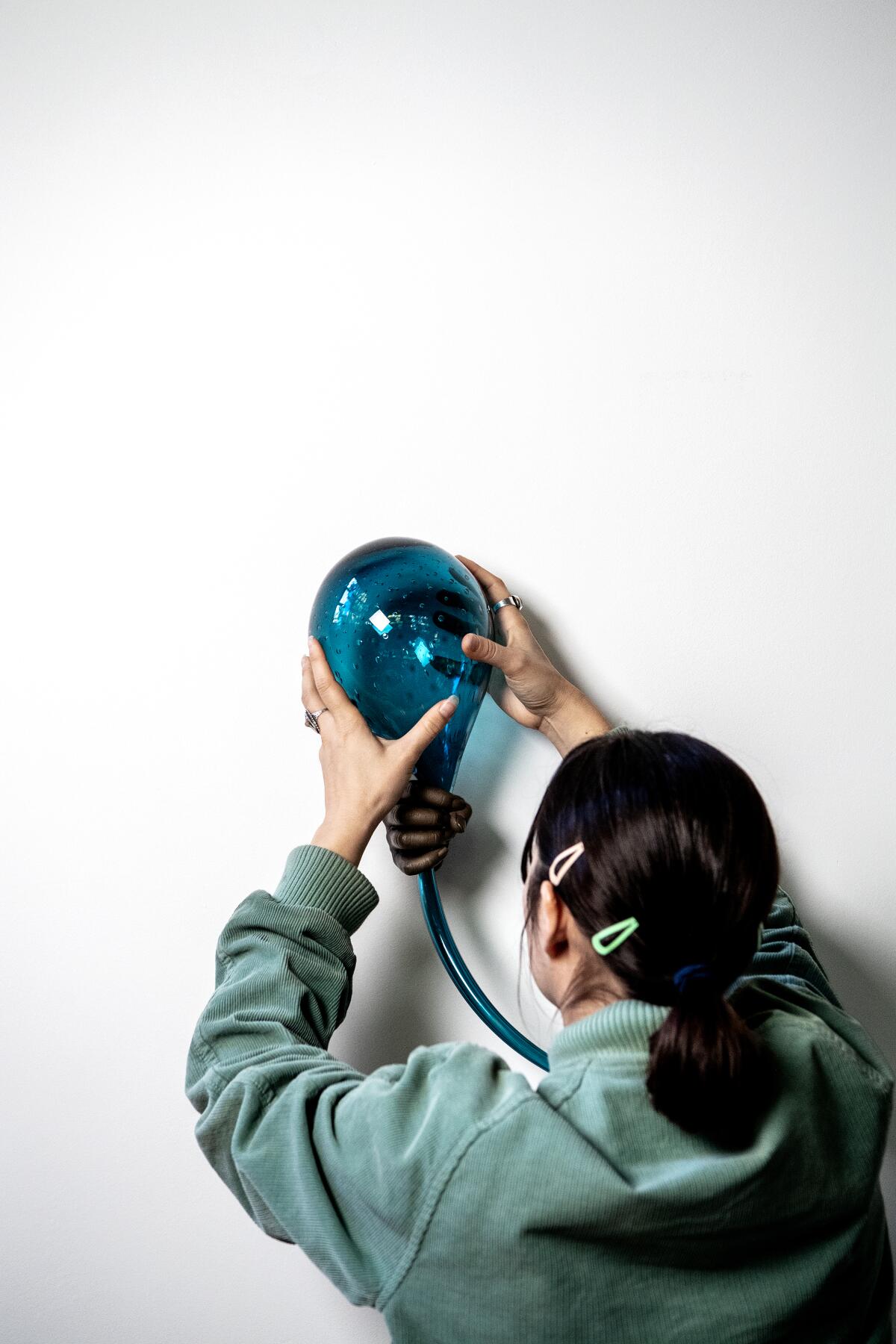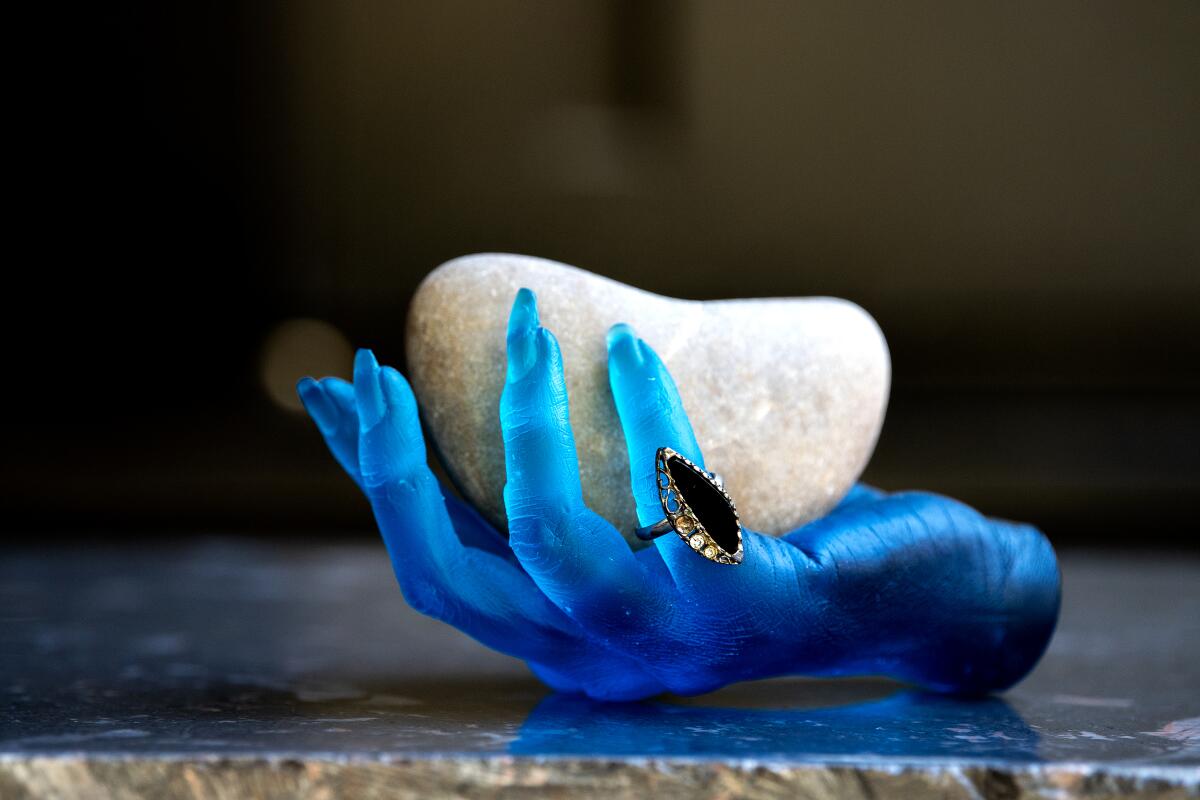How L.A. artist Kelly Akashi’s work evokes tangled feelings about impermanence

- Share via
Kelly Akashi gives new meaning to the phrase “learning by doing.” The Los Angeles-born artist was initially trained in photography but has since taken up candlemaking, glassblowing, bronze casting, and, most recently, stone carving. Her sculptures and photographs evoke tangled feelings about time, impermanence, bodies and our relationship to nature. For her, these lofty themes are rooted not in philosophy or religion, but in the process of making things — and the “conversations” with materials that result.
Akashi, 39, is enjoying her first museum retrospective at the San Jose Museum of Art. (It’s on view through May 21, then travels to the Frye Museum in Seattle and the Museum of Contemporary Art in San Diego.) Dressed casually in a brown T-shirt and jeans with large holes in the knees, she is friendly and welcoming as she sits for a chat in her studio, a converted garage in a quiet Altadena neighborhood.
On a large table to her right are two bright red sculptural pieces cast from her own body: an armless torso and an abdomen with legs dangling as if it has also just sat down for a break. Akashi’s work often combines such casts with other natural or handmade objects, mixing “fine art” materials like marble and bronze with “craft” media like glass or candles. Glass vessels may have breasts, sprout hair or dangle perilously from ropes. A bronze cast of her own hand presses lightly on a deflating glass globe or gingerly cradles a thorny thistle. Candles that suggest body parts or mutant slugs curl across a shelf and transform as they burn.
Her photographs also employ unusual combinations of materials; for one series she used glass objects, arranged only by feel in total darkness, as “negatives” to create color images that resemble nebulae or blood cells.

Although her works might appear spontaneous, Akashi says they are the cumulative result of many carefully considered decisions. “I don’t tend to do a drawing of a finished form,” she says. “I do different steps in the process, and then I want to see what that leads to.” She admits that sometimes the result is failure, like a glass work that shatters or a piece that isn’t ready for prime time. “You don’t know if it’s going to end up in a show or like, in the garden,” she laughs.
Her eyes light up when she talks about her latest fascination: stone carving, which she picked up during the pandemic. She describes how carvers are often attuned to what the stone is telling them, but in addition, “I realized I was projecting things into the stone, and then it’s sort of showing me something in my own mind,” she says. “That’s the kind of material conversation that gets me really excited to continue with a medium.”
Moving outside to a concrete patio lined with tall bamboo, Akashi lifts, with some effort, a lump of dull, pinkish stone about the size of a large baby. “To be frank, there’s, you know, physical limitations in stone carving that I need help with because I don’t have the physical strength,” she says, “but I’m trying to bulk up so it doesn’t matter.”

She notes that chiseling and sanding away at stone is a much slower process than working with other media. “You obviously can’t really add something back, so there’s a lot of looking that happens,” she says. “Looking at it from different perspectives, looking at different light, especially when you’re outside: different times of day, different times of year that will reveal things that you didn’t see last month or the year before.” She carries the pink baby over to a garden hose and sprays it with water. Suddenly the dull, matte rock transforms into a luminous, fleshy mass crisscrossed with thick, white, tendon-like bands.
This respect for the process reflects her faith in craft traditions: strains of knowledge passed from one generation to the next through conversation, teaching and demonstration. She studied photography at Otis College of Art and Design and received her master of fine arts from USC but didn’t learn other craft techniques until later, when her mother taught her to make candles. “That was the first time I really entered a way of making where I was consciously thinking about the fact that it was an oral history,” she says. She also enrolled in a glassblowing class at Santa Monica College, where she noticed that visiting lecturers, unlike those in art school, always gave a demo after their talk. “There’s things you learn from seeing somebody work that they could never explain,” she says.
This kind of intergenerational transmission took on new significance in June 2020 — the early days of the pandemic — when Akashi began making trips to Poston, Ariz., where her Japanese American father was incarcerated with his family during World War II. “It was, like, a weird time to be in that region because everything was shut down, so it was very isolated,” she says, but “that gave me the time to maybe have the slowness to work with these topics and these locations.”
She began by photographing the mostly barren site, thinking about the passage of time on a larger scale. She was drawn to the trees around Poston, which were likely planted by Japanese American prisoners who were farmers and knew how to coax life from the desert. “For me, the site became maybe this connective tissue,” she says, “Geological time is so vast that when my father was there, and when I went to visit that site, it’s a very short amount of time, actually.”
Making this connection was especially important because Akashi’s grandparents and father didn’t speak much about their wartime experiences and had passed away before she began the project. She does have some family photographs taken in the camp, some of which include trees. She selected several of these to reproduce in the exhibition catalog alongside images shot during her visits. Tree branches and pine cones from Poston have also found their way into her sculptural work as bronze casts, witnesses to the incarceration and the decades that have unspooled since.
“I’ve been thinking a lot about mystery,” she says, “and how to keep space for that.” Perhaps personal histories left untold are not unlike conversations with stone that only reveal themselves over time. “The memories of people before us are kind of embedded in our tissue,” she says, adding that you might think “you have no access to those people, but maybe, somehow, they are a part of you or you are hearing them.”
Kelly Akashi: Formations
Where: San Jose Museum of Art, 110 South Market Street, San José, CA.
When: Thursdays 4–9pm, Fridays 11am–9pm, Saturdays and Sundays 11am–6pm. Closed Mondays-Wednesdays. Through May 21, 2023.
Cost: $8-$10
Info: (408) 271-6840, www.sjmusart.org
More to Read
The biggest entertainment stories
Get our big stories about Hollywood, film, television, music, arts, culture and more right in your inbox as soon as they publish.
You may occasionally receive promotional content from the Los Angeles Times.










